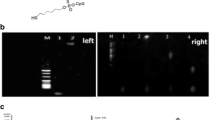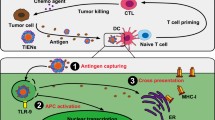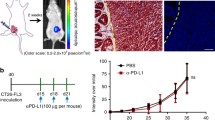Abstract
CpG oligodeoxynucleotides (CpG) potently activate the immune system by mimicking microbial DNA. Conjugation of CpG to chTNT-3, an antibody targeting the necrotic centers of tumors, enabled CpG to accumulate in tumors after systemic delivery, where it can activate the immune system in the presence of tumor antigens. CpG chemically conjugated to chTNT-3 (chTNT-3/CpG) were compared to free CpG in their ability to stimulate the immune system in vitro and reduce tumor burden in vivo. In subcutaneous Colon 26 adenocarcinoma and B16-F10 melanoma models in BALB/c and C57BL/6 mice, respectively, chTNT-3/CpG, free CpG, or several different control constructs were administered systemically. Intraperitoneal injections of chTNT-3/CpG delayed tumor growth and improved survival and were comparable to intratumorally administered CpG. Compared to saline-treated mice, chTNT-3/CpG-treated mice had smaller average tumor volumes by as much as 72 % in Colon 26-bearing mice and 79 % in B16-bearing mice. Systemically delivered free CpG and CpG conjugated to an isotype control antibody did not reduce tumor burden or improve survival. In this study, chTNT-3/CpG retained immunostimulatory activity of the CpG moiety and enabled delivery to tumors. Because systemically administered CpG rapidly clear the body and do not accumulate into tumors, chTNT-3/CpG provide a solution to the limitations observed in preclinical and clinical trials.





Similar content being viewed by others
Abbreviations
- ANOVA:
-
Analysis of variance
- cetuximab/CpG:
-
CpG conjugated to cetuximab
- chTNT-3:
-
Chimeric tumor necrosis therapy-3 antibody
- chTNT-3/CpG:
-
CpG conjugated to chTNT-3
- chTNT-3+CpG:
-
Non-conjugated chTNT-3 and CpG
- CpG:
-
Cytosine guanine dinucleotide
- CpG1585:
-
CpG sequence 1585
- CpG1826:
-
CpG sequence 1826
- DC:
-
Dendritic cell
- DNP:
-
Dinitrophenyl haptens
- EGFR:
-
Epidermal growth factor receptor
- GEE:
-
Generalized estimating equations
- 125I-chTNT-3/CpG:
-
125-Iodinated chTNT-3/CpG
- IFN:
-
Interferon
- i.p.:
-
Intraperitoneal
- i.t.:
-
Intratumoral
- NK cells:
-
Natural killer cells
- PAMPs:
-
Pathogen-associated molecular patterns
- sc1585:
-
Negative control sequence for CpG1585
- sc1826:
-
Negative control sequence for CpG1826
- TCR:
-
T cell receptors
- TDLN:
-
Tumor-draining lymph node
- TH1:
-
T-helper 1
- TLR:
-
Toll-like receptors
- Treg:
-
T regulatory cells
References
Wiemann B, Starnes CO (1994) Coley’s toxins, tumor necrosis factor and cancer research: a historical perspective. Pharmacol Ther 64:529–564
Coley WB (1991) The treatment of malignant tumors by repeated inoculations of erysipelas. With a report of ten original cases. 1893. Clin Orthop Relat Res 262:3–11
Lechner MG, Karimi SS, Barry-Holson K, Angell TE, Murphy KA, Church CH, Ohlfest JR, Hu P, Epstein AL (2013) Immunogenicity of murine solid tumor models as a defining feature of in vivo behavior and response to immunotherapy. J Immunother 36:477–489. doi:10.1097/01.cji.0000436722.46675.4a
Liu Y, Zeng G (2012) Cancer and innate immune system interactions: translational potentials for cancer immunotherapy. J Immunother 35:299–308. doi:10.1097/CJI.0b013e3182518e83
Tokunaga T, Yamamoto H, Shimada S et al (1984) Antitumor activity of deoxyribonucleic acid fraction from Mycobacterium bovis BCG. I. Isolation, physicochemical characterization, and antitumor activity. J Natl Cancer Inst 72:955–962
Chu RS, Targoni OS, Krieg AM, Lehmann PV, Harding CV (1997) CpG oligodeoxynucleotides act as adjuvants that switch on T helper 1 (Th1) immunity. J Exp Med 186:1623–1631
Kawarada Y, Ganss R, Garbi N, Sacher T, Arnold B, Hammerling GJ (2001) NK- and CD8(+) T cell-mediated eradication of established tumors by peritumoral injection of CpG-containing oligodeoxynucleotides. J Immunol 167:5247–5253
Heckelsmiller K, Rall K, Beck S et al (2002) Peritumoral CpG DNA elicits a coordinated response of CD8 T cells and innate effectors to cure established tumors in a murine colon carcinoma model. J Immunol. 169:3892–3899
Sharma S, Karakousis CP, Takita H, Shin K, Brooks SP (2003) Intra-tumoral injection of CpG results in the inhibition of tumor growth in murine Colon-26 and B-16 tumors. Biotechnol Lett 25:149–153
Amos SM, Pegram HJ, Westwood JA et al (2011) Adoptive immunotherapy combined with intratumoral TLR agonist delivery eradicates established melanoma in mice. Cancer Immunol Immunother 60:671–683. doi:10.1007/s00262-011-0984-8
Schettini J, Kidiyoor A, Besmer DM, Tinder TL, Roy LD, Lustgarten J, Gendler SJ, Mukherjee P (2012) Intratumoral delivery of CpG-conjugated anti-MUC1 antibody enhances NK cell anti-tumor activity. Cancer Immunol Immunother 61:2055–2065. doi:10.1007/s00262-012-1264-y
Auf G, Chen L, Fornes P, Le Clanche C, Delattre JY, Carpentier AF (2002) CpG-oligodeoxynucleotide rejection of a neuroblastoma in A/J mice does not induce a paraneoplastic disease. Neurosci Lett 327:189–192
Betting DJ, Yamada RE, Kafi K, Said J, van Rooijen N, Timmerman JM (2009) Intratumoral but not systemic delivery of CpG oligodeoxynucleotide augments the efficacy of anti-CD20 monoclonal antibody therapy against B cell lymphoma. J Immunother 32:622–631. doi:10.1097/CJI.0b013e3181ab23f1
Murad YM, Clay TM (2009) CpG oligodeoxynucleotides as TLR9 agonists: therapeutic applications in cancer. BioDrugs 23:361–375. doi:10.2165/11316930-000000000-00000
Holtick U, Scheulen ME, von Bergwelt-Baildon MS, Weihrauch MR (2011) Toll-like receptor 9 agonists as cancer therapeutics. Expert Opin Investig Drugs 20:361–372. doi:10.1517/13543784.2011.553187
Link BK, Ballas ZK, Weisdorf D, Wooldridge JE, Bossler AD, Shannon M, Rasmussen WL, Krieg AM, Weiner GJ (2006) Oligodeoxynucleotide CpG 7909 delivered as intravenous infusion demonstrates immunologic modulation in patients with previously treated non-Hodgkin lymphoma. J Immunother 29:558–568. doi:10.1097/01.cji.0000211304.60126.8f
Weber JS, Zarour H, Redman B, Trefzer U, O’Day S, van den Eertwegh AJ, Marshall E, Wagner S (2009) Randomized phase 2/3 trial of CpG oligodeoxynucleotide PF-3512676 alone or with dacarbazine for patients with unresectable stage III and IV melanoma. Cancer 115:3944–3954. doi:10.1002/cncr.24473
Shirota Y, Shirota H, Klinman DM (2012) Intratumoral injection of CpG oligonucleotides induces the differentiation and reduces the immunosuppressive activity of myeloid-derived suppressor cells. J Immunol 188:1592–1599. doi:10.4049/jimmunol.1101304
Brody JD, Ai WZ, Czerwinski DK et al (2010) In situ vaccination with a TLR9 agonist induces systemic lymphoma regression: a phase I/II study. J Clin Oncol 28:4324–4332. doi:10.1200/JCO.2010.28.9793
Kim YH, Gratzinger D, Harrison C et al (2012) In situ vaccination against mycosis fungoides by intratumoral injection of a TLR9 agonist combined with radiation: a phase 1/2 study. Blood 119:355–363. doi:10.1182/blood-2011-05-355222
Wingender G, Garbi N, Schumak B et al (2006) Systemic application of CpG-rich DNA suppresses adaptive T cell immunity via induction of IDO. Eur J Immunol 36:12–20. doi:10.1002/eji.200535602
Hofmann MA, Kors C, Audring H, Walden P, Sterry W, Trefzer U (2008) Phase 1 evaluation of intralesionally injected TLR9-agonist PF-3512676 in patients with basal cell carcinoma or metastatic melanoma. J Immunother 31:520–527. doi:10.1097/CJI.0b013e318174a4df
Li Z, Jang JK, Lechner MG, Hu P, Khawli L, Scannell CA, Epstein AL (2013) Generation of tumor-targeted antibody-CpG conjugates. J Immunol Methods 389:45–51. doi:10.1016/j.jim.2012.12.009
Hornick JL, Sharifi J, Khawli LA, Hu P, Biela BH, Mizokami MM, Yun A, Taylor CR, Epstein AL (1998) A new chemically modified chimeric TNT-3 monoclonal antibody directed against DNA for the radioimmunotherapy of solid tumors. Cancer Biother Radiopharm. 13:255–268
Epstein AL, Chen FM, Taylor CR (1988) A novel method for the detection of necrotic lesions in human cancers. Cancer Res 48:5842–5848
Chen S, Yu L, Jiang C et al (2005) Pivotal study of iodine-131-labeled chimeric tumor necrosis treatment radioimmunotherapy in patients with advanced lung cancer. J Clin Oncol 23:1538–1547. doi:10.1200/JCO.2005.06.108
Hdeib A, Sloan A (2012) Targeted radioimmunotherapy: the role of (1)(3)(1)I-chTNT-1/B mAb (Cotara) for treatment of high-grade gliomas. Future Oncol 8:659–669. doi:10.2217/fon.12.58
Yu L, Ju DW, Chen W et al (2006) 131I-chTNT radioimmunotherapy of 43 patients with advanced lung cancer. Cancer Biother Radiopharm 21:5–14. doi:10.1089/cbr.2006.21.5
van den Heuvel MM, Verheij M, Boshuizen R et al (2015) NHS-IL2 combined with radiotherapy: preclinical rationale and phase Ib trial results in metastatic non-small cell lung cancer following first-line chemotherapy. J Transl Med 13:32. doi:10.1186/s12967-015-0397-0
Li J, Hu P, Khawli LA, Epstein AL (2003) Complete regression of experimental solid tumors by combination LEC/chTNT-3 immunotherapy and CD25(+) T-cell depletion. Cancer Res 63:8384–8392
Khawli LA, Biela B, Hu P, Epstein AL (2003) Comparison of recombinant derivatives of chimeric TNT-3 antibody for the radioimaging of solid tumors. Hybrid Hybridomics 22:1–9. doi:10.1089/153685903321538026
Flanagan ML, Khawli LA, Hu P, Epstein AL (2006) H60/TNT-3 fusion protein activates NK cells in vitro and improves immunotherapeutic outcome in murine syngeneic tumor models. J Immunother 29:274–283. doi:10.1097/01.cji.0000199194.90222.1a
Mizokami MM, Hu P, Khawli LA, Li J, Epstein AL (2003) Chimeric TNT-3 antibody/murine interferon-gamma fusion protein for the immunotherapy of solid malignancies. Hybrid Hybridomics 22:197–207. doi:10.1089/153685903322328929
Hornick JL, Sharifi J, Khawli LA, Hu P, Bai WG, Alauddin MM, Mizokami MM, Epstein AL (2000) Single amino acid substitution in the Fc region of chimeric TNT-3 antibody accelerates clearance and improves immunoscintigraphy of solid tumors. J Nucl Med 41:355–362
Jang JK, Khawli LA, Park R, Wu BW, Li Z, Canter D, Conti PS, Epstein AL (2013) Cytoreductive chemotherapy improves the biodistribution of antibodies directed against tumor necrosis in murine solid tumor models. Mol Cancer Ther 12:2827–2836. doi:10.1158/1535-7163.MCT-13-0383
Krieg AM, Yi AK, Matson S, Waldschmidt TJ, Bishop GA, Teasdale R, Koretzky GA, Klinman DM (1995) CpG motifs in bacterial DNA trigger direct B-cell activation. Nature 374:546–549. doi:10.1038/374546a0
Krug A, Rothenfusser S, Hornung V, Jahrsdorfer B, Blackwell S, Ballas ZK, Endres S, Krieg AM, Hartmann G (2001) Identification of CpG oligonucleotide sequences with high induction of IFN-alpha/beta in plasmacytoid dendritic cells. Eur J Immunol 31:2154–2163. doi:10.1002/1521-4141(200107)31:7<2154:AID-IMMU2154>3.0.CO;2-U
Sen D, Gilbert W (1988) Formation of parallel four-stranded complexes by guanine-rich motifs in DNA and its implications for meiosis. Nature 334:364–366. doi:10.1038/334364a0
Kerkmann M, Costa LT, Richter C et al (2005) Spontaneous formation of nucleic acid-based nanoparticles is responsible for high interferon-alpha induction by CpG-A in plasmacytoid dendritic cells. J Biol Chem 280:8086–8093. doi:10.1074/jbc.M410868200
Khawli LA, Mizokami MM, Sharifi J, Hu P, Epstein AL (2002) Pharmacokinetic characteristics and biodistribution of radioiodinated chimeric TNT-1, -2, and -3 monoclonal antibodies after chemical modification with biotin. Cancer Biother Radiopharm 17:359–370. doi:10.1089/108497802760363150
Sharma S, Dominguez AL, Manrique SZ, Cavallo F, Sakaguchi S, Lustgarten J (2008) Systemic targeting of CpG-ODN to the tumor microenvironment with anti-neu-CpG hybrid molecule and T regulatory cell depletion induces memory responses in BALB-neuT tolerant mice. Cancer Res 68:7530–7540. doi:10.1158/0008-5472.CAN-08-1635
Palma E, Cho MJ (2007) Improved systemic pharmacokinetics, biodistribution, and antitumor activity of CpG oligodeoxynucleotides complexed to endogenous antibodies in vivo. J Control Release. 120:95–103. doi:10.1016/j.jconrel.2007.03.016
Lechner MG, Russell SM, Bass RS, Epstein AL (2011) Chemokines, costimulatory molecules and fusion proteins for the immunotherapy of solid tumors. Immunotherapy 3:1317–1340. doi:10.2217/imt.11.115
Tzeng A, Kwan BH, Opel CF, Navaratna T, Wittrup KD (2015) Antigen specificity can be irrelevant to immunocytokine efficacy and biodistribution. Proc Natl Acad Sci USA 112:3320–3325. doi:10.1073/pnas.1416159112
Teng MW, Andrews DM, McLaughlin N et al (2010) IL-23 suppresses innate immune response independently of IL-17A during carcinogenesis and metastasis. Proc Natl Acad Sci USA 107:8328–8333. doi:10.1073/pnas.1003251107
Lo CH, Lee SC, Wu PY et al (2003) Antitumor and antimetastatic activity of IL-23. J Immunol 171:600–607
Kaiga T, Sato M, Kaneda H, Iwakura Y, Takayama T, Tahara H (2007) Systemic administration of IL-23 induces potent antitumor immunity primarily mediated through Th1-type response in association with the endogenously expressed IL-12. J Immunol. 178:7571–7580
Houot R, Levy R (2009) T-cell modulation combined with intratumoral CpG cures lymphoma in a mouse model without the need for chemotherapy. Blood 113:3546–3552. doi:10.1182/blood-2008-07-170274
Mangsbo SM, Sandin LC, Anger K, Korman AJ, Loskog A, Totterman TH (2010) Enhanced tumor eradication by combining CTLA-4 or PD-1 blockade with CpG therapy. J Immunother 33:225–235. doi:10.1097/CJI.0b013e3181c01fcb
Marabelle A, Kohrt H, Sagiv-Barfi I et al (2013) Depleting tumor-specific Tregs at a single site eradicates disseminated tumors. J Clin Invest. 123:2447–2463. doi:10.1172/JCI64859
Acknowledgments
The authors would like to acknowledge Dr. Wendy Jean Mack (University of Southern California) for statistical assistance. The project described was supported in part by National Center for Advancing Translational Sciences (NCATS award UL1TR00013) and National Cancer Institute (NCI award P30CA014089). Julie K. Jang and Brian W. Wu are TL1 trainees under Southern California Clinical and Translational Science Institute (SC CTSI) (NCATS award TL1TR000132).
Author information
Authors and Affiliations
Corresponding author
Ethics declarations
Conflict of interest
Peisheng Hu and Alan L. Epstein are co-founders of Cancer Therapeutics Laboratories, Inc. This study was partially funded by Cancer Therapeutics Laboratories, Inc. All other authors declare no conflict of interest.
Electronic supplementary material
Below is the link to the electronic supplementary material.
Rights and permissions
About this article
Cite this article
Jang, J.K., Khawli, L.A., Canter, D.C. et al. Systemic delivery of chTNT-3/CpG immunoconjugates for immunotherapy in murine solid tumor models. Cancer Immunol Immunother 65, 511–523 (2016). https://doi.org/10.1007/s00262-016-1813-x
Received:
Accepted:
Published:
Issue Date:
DOI: https://doi.org/10.1007/s00262-016-1813-x




